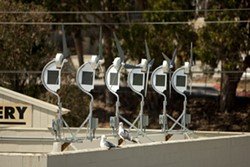Windmills are typically big. The giant, spinning blades operate like simple levers, and the longer they are, the harder they can push the turbines to convert passing wind into electrical currents. The process is relatively inefficient and unreliable, so builders in the past needed a lot of space to make windmills large enough to crank out real juice whenever a gust kicked up.

- PHOTO BY STEVE E. MILLER
- TESTING THE WIND : Crizer Wind Energy, Inc. installed dozens of miniature wind turbines in Morro Bay to test the idealistic but skepticism-inducing claims of DyoCore, a manufacturer now under investigation by the California Energy Commission.
These days, thanks to advances in technology, engineers can design windmills that pull more energy from less wind, paving the way for smaller structures that even Don Quixote could crush. But the ordinance that controls construction of wind turbines in San Luis Obispo County was written long ago. Currently, only parcels that are an acre or larger are zoned for windmills.
“You can install a wind system on smaller parcels, but you need a discretionary permit,” said John Busselle, a public information representative with SLO County’s Department of Planning and Building. “They cost more money and take more time. It’s a disincentive to build.”
The county has to approve small wind energy systems on a case-by-case basis, but they’re writing a set of uniform standards that would streamline the permit process. The current draft is circulating among interested parties and advisory groups, and the department will hear their concerns before bringing the ordinance to the Planning Commission and then the Board of Supervisors, where it will be open for public comment. Busselle expects an ordinance to be implemented by the spring of 2012.
“We would limit each parcel to a 50 kilowatt system,” Busselle said. “This is designed for individual power consumption, not to create a bunch of commercial wind farms.”
The draft requires systems to meet noise restrictions, include safety signage, and be constructed below ridge lines when viewed from designated scenic highways. It calls for paint colors that blend with the turbine’s surroundings and would allow 100-foot-tall windmills to be built on five-acre parcels. It also includes provisions for a new style of roof-mounted system, though no one’s certain whether these youthful windcatchers will function as well as the manufacturer claimed.
The only roof-mounted turbine approved by the California Energy Commission (CEC) is made by a company in San Diego called DyoCore. According to spokesman Craig Herdrich, DyoCore’s tiny turbines are incredibly cheap, can generate power with wind speeds as slow as five miles per hour, and can withstand typhoon conditions. They work by collaborating different voltage patterns of wind and solar to the same hertz frequency, a process that promised to combine the two energy sources for the first time.
“It does a million great things with no drawbacks,” Herdrich said.
Since 1998, the commission’s Emerging Renewable Program gave rebates of $3 per watt to home and business owners for installing sustainable energy systems on their properties. Over a 12-year period, 577 customers received such rebates. Then, with the release of DyoCore’s turbines in 2010, staffers were flooded with more than 1,000 rebate applications.
The turbines were rated to produce enough energy to cover the $2,000 cost of installation, which made them essentially free to consumers while the state footed the bill.
In March 2011, the rebate program was temporarily suspended. Amy Morgan of the CEC told New Times the state is drafting new guidelines that would cap rebates at 50 percent of installation cost and keep manufacturers from testing their own products.
“We filed a complaint against DyoCore on July 27 for grossly overstating the efficiency of their turbines,” Morgan said.
The CEC had a third-party energy consultant test DyoCore’s data and found that the company’s efficiency claim was 7.5 times greater than what was theoretically possible.
David Raine, CEO of DyoCore, contends that the data he submitted to the CEC was correct, but that the commission extrapolated higher energy output based on higher possible wind speeds. He said their error created the entire fiasco.
Local tests of the product don’t look good. Before the rebate program was suspended, Crizer Wind Energy, Inc. approached several Morro Bay businesses with a plan to test the turbines for a full year before taking them to consumers.
So far, none of the business owners are seeing any savings on their utility bills, and some owners are worried that the “improvement” might add to their property taxes. The county Assessor’s Office said solar projects are protected, but there’s nothing on the books to prevent windmills from adding to a property’s value and increasing taxes owed. Dan Lapp of Morro Doors said Crizer offered to remove the turbines at no charge.
“We started this because it was listed on the CEC website as a low-wind, high-energy product,” Bob Crizer said. “To say they don’t work would be incorrect, but it is safe to say they were overrated.”
Crizer got into wind energy after a college scouting trip with his son took him to a Massachusetts town powered entirely by two large turbines. The community had come together and taxed themselves to pay for the construction. It inspired him to seek out clean energy solutions in California.
Crizer was always more interested in larger turbines and is in the process of scouting potential sites around the county. He said he supports the CEC rebate suspension because of its potential for abuse but added that some kind of state subsidies are necessary to get clean energy off the ground.
“We’re a neophyte group trying things the old wind guys would never do,” Crizer said. “You have to explore every option for renewable energy every day of every year until we can get off of fossil fuels entirely.”
Contact Calendar Editor Nick Powell at [email protected].
Comments